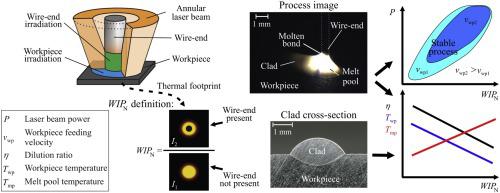Journal of Materials Processing Technology ( IF 6.7 ) Pub Date : 2021-02-17 , DOI: 10.1016/j.jmatprotec.2021.117105 Matjaž Kotar , Makoto Fujishima , Gideon N. Levy , Edvard Govekar

|
This paper experimentally studies the influence of conventional process parameters (laser beam power, P, workpiece, and wire feeding velocities), and the nominal workpiece irradiation proportion WIPN parameter, on ALB-WC process stability and generated clad geometry. The study was based on an extensive set of single clad experiments using stainless steel AISI 316L wire of 0.6 mm diameter and a stainless steel AISI 304 workpiece. The results show that the laser beam power required for a stable process increases non-linearly with WIPN, and this relationship can be described by quadratic regression. An increase in either the workpiece or wire feeding velocity respectively causes a reduction or enlargement of the stability region in the P-WIPN stability diagrams. The influences on stability diagrams are explained by means of the increase in the nominal WIPN to the effective WIPE, as a result of the clad height generated. With respect to clad geometry, it was shown that an increase in the WIPN causes a decrease in the dilution ratio, which is linearly correlated with the workpiece and melt pool temperatures, while clad width and height are not influenced by the WIPN. The paper further explains the complex influences of the process parameters observed on process stability and generated clad geometry using a phenomenological description of the ALB-WC process at a low and high nominal WIPN. For this purpose, heat transfer, Marangoni flow, and laser beam reflections are considered qualitatively and supported by IR and visual images of the wire-end and melt pool as well as the workpiece and melt pool temperatures.
中文翻译:

对环形激光束熔覆工艺的理解进展
本文通过实验研究了常规工艺参数(激光束功率,P,工件和送丝速度)以及名义工件辐照比WIP N参数对ALB-WC工艺稳定性和生成的包层几何形状的影响。该研究基于一组广泛的单包实验,使用的是直径为0.6 mm的AISI 316L不锈钢丝和AISI 304不锈钢工件。结果表明,稳定过程所需的激光束功率随WIP N呈非线性增加,并且这种关系可用二次回归来描述。工件或焊丝进给速度的增加分别导致工件中稳定区域的减小或增大。P - WIP N稳定性图。通过产生的包层高度,通过将额定WIP N增加到有效WIP E来解释对稳定性图的影响。关于包层的几何形状,已表明,WIP N的增加会导致稀释比的降低,这与工件和熔池温度成线性关系,而包层的宽度和高度不受WIP N的影响。。本文使用在低标称WIP N和高标称WIP N下的ALB-WC工艺的现象学描述,进一步解释了所观察到的工艺参数对工艺稳定性和生成的包层几何形状的复杂影响。为此,定性地考虑了传热,Marangoni流动和激光束反射,并通过IR和线端和熔池以及工件和熔池温度的可视图像进行支持。











































 京公网安备 11010802027423号
京公网安备 11010802027423号